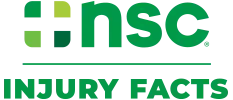Detailed nonfatal data over 2021- 2022
The U.S. Bureau of Labor Statistics (BLS) has transitioned from an annual to a biennial (every two years) publication schedule. The final publication of a single year of cases involving days away from work estimates was for reference year 2020. BLS now publishes detailed data covering 2021 and 2022 for Days Away from Work (DAFW), Days of Job Transfer or Restriction (DJTR), and Days Away from Work, Job Restriction, or Transfer (DART) cases.
Over 2021-2022, overexertion and bodily reaction had the most DART cases at 1,001,440, followed by contact with objects and equipment with 780,690 cases, falls, slips, trips with 674,100 cases, and exposure to harmful substances or environments with 658,240 cases.
Notably, 96.3% of the total exposure to harmful substances or environments cases (634,080 of the 658,240 total DART cases) involved at least one day away from work. Of the total DART cases due to overexertion and bodily reaction, 521,350 cases (52.1%) were DAFW cases.
Because of illness cases related to COVID-19, the leading cause of work-related injuries and illnesses involving days away from work over 2021-2022 is exposure to harmful substances or environments. Exposure to harmful substances or environments was previously the sixth ranked cause. The next two most prevalent causes of injury and illness involving days away from work are overexertion and bodily reaction and slips, trips and falls. These top three causes account for more than 75% of all nonfatal injuries and illnesses involving days away from work.
Exposure to harmful substances or environments includes:
-
- Exposure to electricity
- Exposure to radiation and noise
- Exposure to temperature extremes
- Exposure to air and water pressure change
- Exposure to other harmful substances
- Includes contagious and infectious diseases such as COVID-19
- Exposure to oxygen deficiency, n.e.c.
- Exposure to traumatic or stressful event, n.e.c.
Overexertion and bodily reaction includes:
-
- Non-impact injuries: Resulting from excessive physical effort directed at an outside source; common activities include lifting, pushing, turning, holding, carrying, or throwing
- Repetitive motion: Microtasks resulting in stress or strain on some part of the body due to the repetitive nature of the task, typically without strenuous effort such as heavy lifting
Slips, trips and falls include the following types of events:
-
- Slips and trips without falling: Injuries occurring when a worker catches themselves from falling due to slip or trip
- Falling on the same level: Includes tripping, slipping, falling while sitting, and falling onto or against object on the same level
- Falling to a lower level: Includes falling from a collapsing structure, falling through surfaces, and falling from ladders, roofs, scaffolding, or other structures
- Jumping to a lower level: Different from falls because they are controlled and voluntary
Prior to 2020, contact with objects and equipment was the third leading cause of injury and illness involving days away from work and accounted for 16.7% of cases in 2020.
Contact with objects and equipment, including:
-
- A moving object striking a worker
- A worker striking against an object or equipment, including bumping into, stepping on, kicking, or being pushed or thrown onto an object
- A part of a worker’s body being squeezed, pinched, compressed, or crushed in equipment, between shifting objects, between stationary objects, or in a wire or rope
- A worker being struck, caught, or crushed in collapsing structure, equipment, or material
- A worker being injured as a result of friction or pressure between the person and the source of injury
- A worker being injured from vibration
This infographic provides a summary of the eight leading nonfatal work-related injuries involving days away from work in 2021-2022. Please visit the data details tab for additional information on both nonfatal and fatal injury events.
